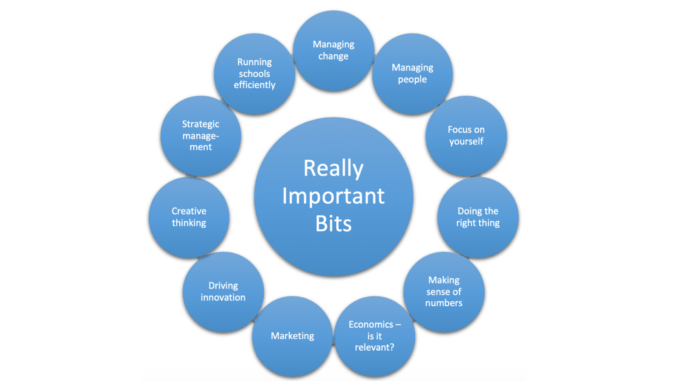
In the final instalment of his ‘Really Important Bits’ (RIBs) series, STEPHEN MITCHELL, chief operating officer at the Spencer Academies Trust, Nottingham, examines some of the issues around making sustainable decisions, how his previous RIBs articles all contribute to the process, and considers some of the tools available for guiding such decisions – in particular, financial ones
This series of articles was started over a year ago, based around the concept of reviewing each of the modules within a MBA – taking the important elements and making them relevant to us in our work in schools.
Articles have been written in this magazine covering all of the topics in the above image, and this final one will lean on the learnings within each of these.
It is impossible to make a truly sustainable decision without one of the other 11 areas having a bearing on your decision-making. However, recognising that there may be more than one area that needs consideration – and incorporating that – is the difference between a decision which answers a specific issue, and one that positively adds to the sustainability of the organisation.
The whole picture
The time has come for us to stand up and be counted; financial pressures on schools have never been more acute than they are now. Therefore, we have to make decisions that are not just financially sensible, but also sustainable for the whole organisation.
I’m aware of schools and academies across the country which have made decisions solely on what the accounts are saying, rather than considering the whole picture – the impact on teaching and learning, and the likely impact on future decisions.
I have a saying that a wise man once told me. ‘You can cost-control yourself out of a crisis, but you can’t cost-control yourself a future’. You have to grab hold of what it is the organisation does, and become excellent at that, at a price point at which it is sustainable. Schools aren’t businesses, yet we have to adopt the business reality of living within our means.
Look up as well as down
In financially challenging times it is easy to spend all of your energy looking at where ‘waste’ can be cut. The law of diminishing returns clearly applies here, and you can only go so far before quality of delivery is impacted.
I’ve seen many people lament the advice from government, albeit quite tone deaf (again), that schools should seek to save money on printing costs. Yes, we should, and the savings can be quite big. Our trust is well on the way to saving the best part of £200,000 per annum compared to prior spend, but that doesn’t tell the whole story.
I’ve had a fairly heated debate with our supplier who pointed out an anomaly in the numbers where one of our schools appears to be disproportionately printing in colour. These numbers would drive me to issue an edict of enforcing mono print only, but it would be crazy to do that without understanding why the printing ratios are different – and there are very good reasons for the high level of colour print we have in that school. Therefore, the most sustainable decision has been to replace our kit with printers that are cheaper to run for colour, in volume, rather than hampering the quality of the output of the school.
Similarly, we shouldn’t just be seeking to cut costs in order to solve our current predicament. There will be opportunities for all schools to drive income further, be it by identifying other grant funding streams, new commercial opportunities, or collaborating with other schools and organisations.
Be brutally realistic
Financial accounts don’t lie…except when they don’t tell the entire story. I recently saw a news article about thousands of heads writing to parents across the country lamenting the funding crisis, and one head has spoken out about having to clean the toilets and serve food in the kitchen in order to help make ends meet.
Well, the question – and we don’t know the answer to this – also has to be asked about how efficiently and effectively costs are being managed here. Has the school made use of integrated curriculum financial planning, and what assumptions are being made about budgets?
I’ve been shocked in recent months to see Twitter full of comments from SBLs saying they’re assuming – and including – the continuation of the teachers’ pay grant, for example, because, without it, the budgets won’t work. Well, it is our job to work with school leaders to make the budgets balance.
We have to be brutally realistic, revisit what we think we know about our schools, and question everything; including assumptions about a pay grant when we’ve been told it won’t continue is just madness. Let’s hope that the Spending Review does include amendments to school financing…but let’s also be brutally realistic, and know the position we’re currently looking at.
Look to the longer-term
We’re all driven to report numbers and metrics across the whole gamut of areas we’re responsible for. This, inevitably, drives a short-term focus on immediate results but, if we’re not careful, this can jeopardise future performance. This is true of financial short-term cost-saving measures, and/or operational decisions.
It’s a bit akin to the ‘razor blade’ or the ‘coffee capsule’ pricing strategy. The initial, up front cost of a decision can be very low, but the ongoing cost of the service can soon mount up to big oodles of money. Working out the total cost of a product or service may just change your view on that procurement decision you’re contemplating.
This article featured in the April issue of Education Executive. Subscribe now to keep up-to-date with the latest in school business management and leadership.
Don’t forget to follow us on Twitter, like us on Facebook, or connect with us on LinkedIn!


Be the first to comment